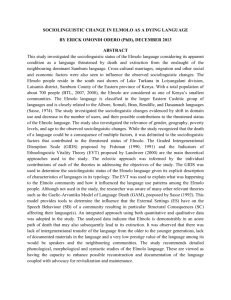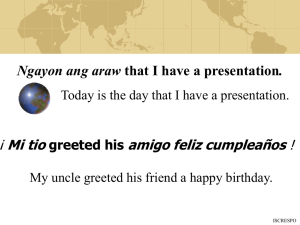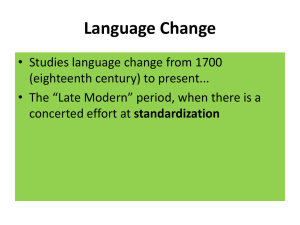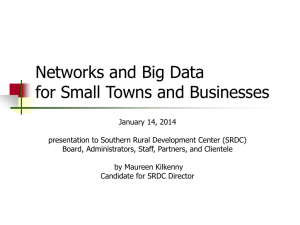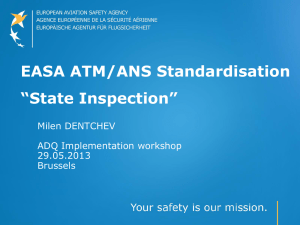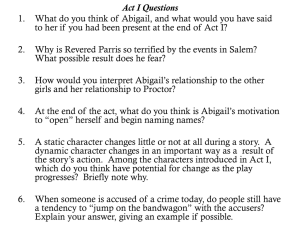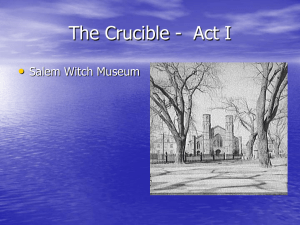Chapter 2 powerpoint
advertisement
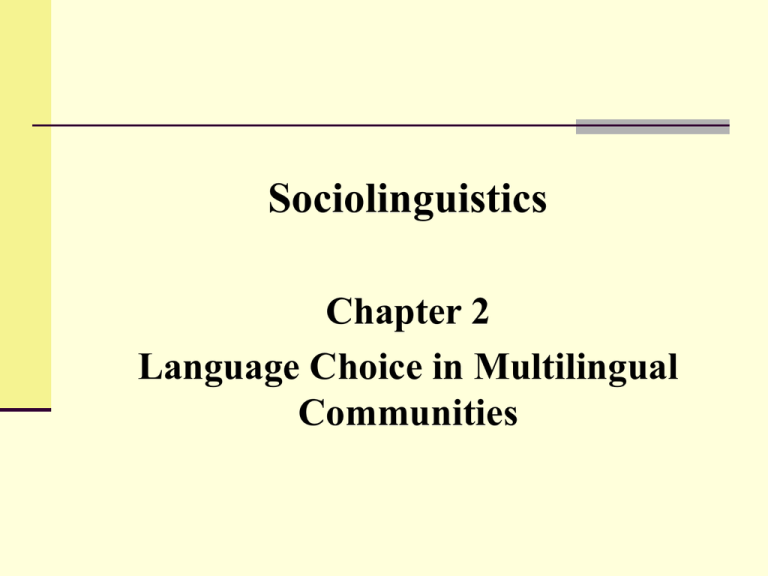
Sociolinguistics Chapter 2 Language Choice in Multilingual Communities Learning Objectives Communicative repertoire Diglossia Code-switching and code-mixing Language variation 1. Different styles 2. Different pronunciation 3. Different vocabulary 4. Different grammar 5. Different dialects 6. Different languages Language variation 1. Participants 2. Setting 3. Topic 4. Function Communicative Repertoire Activity 2.1 The languages in your life: your communicative repertoire Communicative repertoire Listen Speak Read Write Cantonese Cantonese Traditional Chinese Traditional Chinese Putonghua Putonghua Simplified Chinese Simplified Chinese English English English English Toishan Toishan Chiuchow Communicative repertoire A tool kit of linguistic and communicative resources Breadth – number of languages you speak Depth – Level of development of each language Domains of language use Typical interactions e.g. family participants setting topic e.g. Table 2.2 family members home family matters Modelling code choice Domain is a general concept involving social factors in code choice such as participants, setting, and topic. It is possible to draw a simple model summarising language use in a community. Example 4, Figure 2.1 Diglossia “The situation where two varieties of a language exist side by side throughout the community, with each having a definite role to play.” (Ferguson, 1959) Diglossia 1. Two distinct varieties of the same language are used in the community, with one regarded as a high (H) variety and the other a low (L) variety. 2. Each variety is used for quite distinct functions; H and L complement each other. 3. No one uses the H variety in everyday conversation. Diglossia Activity 2.2 Functional distribution of H and L varieties across different domains of language use in diglossic situations Diglossia Domains of Language Use Sermon in church or mosque H L Instructions to servants, waiters, workmen, clerks Personal letter Speech in parliament, legislative councils, political speech University lecture Conversation with family, friends, colleagues News broadcast TV ‘soap opera’ Newspaper editorial, news story, caption on picture Poetry Folk literature Popular youth magazines Facebook, Line, WhatsApp, Skype, Google Talk, WeChat Criteria for diglossia (Fasold, 1984) Function Prestige Literary Heritage Acquisition Standardisation Stability Grammar Lexicon Phonology Criteria for diglossia (Fasold, 1984) Function Prestige Literary Heritage Acquisition Standardisation Stability Grammar Lexicon Phonology Prestige H is superior to L. There is a usual belief that H is somehow more beautiful, more logical, better able to express important thoughts. This belief is also held by speakers whose command of H is quite limited. Criteria for diglossia (Fasold, 1984) Function Prestige Literary Heritage Acquisition Standardisation Stability Grammar Lexicon Phonology Literary heritage A sizeable body of written literature in H is held in high esteem by the speech community. Contemporary writers tend to use words, phrases, or constructions which were used in literary history. 18 Criteria for diglossia (Fasold, 1984) Function Prestige Literary Heritage Acquisition Standardisation Stability Grammar Lexicon Phonology Acquisition L is learned by children in what may be regarded as the "normal" way of learning one's mother tongue. H is chiefly learnt by means of formal education. Acquisition The grammatical structure of L is learned without explicit discussion of grammatical concepts; the grammar of H is learned in terms of "rules" and norms to be imitated. Criteria for diglossia (Fasold, 1984) Function Prestige Literary Heritage Acquisition Standardisation Stability Grammar Lexicon Phonology Standardisation There is a strong tradition of grammatical study of the H form of the language. There are grammars, dictionaries, treaties on pronunciation, style and so on. The orthography is well established and has little variation. For the L variety, there is no settled orthography and there is wide variation in pronunciation, grammar, and vocabulary. Criteria for diglossia (Fasold, 1984) Function Prestige Literary Heritage Acquisition Standardisation Stability Grammar Lexicon Phonology Stability Diglossia typically persists at least several centuries, and evidence in some cases seems to show that it can last well over a thousand years. The communicative tensions arisen in diglossia situation may be resolved by the use of relatively uncodified, unstable, intermediate forms of the language and repeated borrowings of vocabulary items from H to L. Criteria for diglossia (Fasold, 1984) Function Prestige Literary Heritage Acquisition Standardisation Stability Grammar Lexicon Phonology Grammar H is more rule-governed. H has grammatical categories not present in L and has an inflectional system of nouns and verbs which is much reduced or totally absent in L. For example, Standard German has four cases in the noun and two indicative tenses in the verb; Swiss German has three cases in the noun and only one simple tense. Criteria for diglossia (Fasold, 1984) Function Prestige Literary Heritage Acquisition Standardisation Stability Grammar Lexicon Phonology Lexicon Generally speaking, the vocabulary of H and L is shared. H includes in its total lexicon technical terms and learned expressions which have no regular L equivalents. L includes popular expressions and the names of very homely objects. Lexicon There is existence of many paired items, one H and one L. Lexicon Greek H ikos idhor eteke als L spiti nero eyenise ma house water gave birth but Lexicon American H illumination purchase children L light buy kids Criteria for diglossia (Fasold, 1984) Function Prestige Literary Heritage Acquisition Standardisation Stability Grammar Lexicon Phonology Phonology H and L phonologies may be: quite close, as in the two varieties of Greek; strikingly divergent, as in Standard German and Swiss German. Extended definition of diglossia Fishman (1967, 1971) extended the notion of diglossia to any situation in which different linguistic varieties have functionally differentiated roles in a society. Diglossia and bilingualism Diglossia A characteristic of speech communities Bilingualism A characteristic of individuals 4 possible situations of diglossia + Bilingualism - Bilingualism + Diglossia + Diglossia + Bilingualism + Diglossia - Bilingualism - Diglossia - Diglossia + Bilingualism - Diglossia -Bilingualism Polyglossia Fasold (1984) proposed the term ‘polyglossia’ to describe a situation in which there are more than 2 languages or varieties which stand in mutually exclusive functional relations with each other. Polyglossia One standard language is used as a H form in several different speech communities, each of which employs its own L variety. High Low 1 Low 2 Low 3 Low 4 Triglossia Three languages, A, B and C. In relation to language A, language B is L; in relation to language C, however, language B is H. Such a case has been termed double overlapping diglossia e.g. Tanzania Triglossia ______________________________________ English H ____________________________________ H Swahili L ____________________________________ L Vernacular ____________________________________ Double-nested diglossia H and L varieties are each themselves subdivided into H and L varieties e.g. Khalapur, India Double-nested diglossia H Oratorical style -------------Hindi-------------L Conversational style H Saf boli ------------Khalapur---------- L Moti boli H L Linear polyglossia Three or more languages or varieties are on a continuum from H to L e.g. Malaysia Linear polyglossia Formal Malaysian English H1 Bahasa Malaysia H2 Mandarin DH Colloquial Malaysian English M1 Dominant Chinese language M2 ‘Native’ Chinese language L1 Other Chinese languages L2-Ln Bazaar Malay L- Diglossia in Hong Kong Chinese Speech Community Spoken language (口語) L : Cantonese Book language (書面語) H : Putonghua and standard written Chinese Triglossia ______________________________________ English H ____________________________________ H Standard Chinese L ____________________________________ L Cantonese ____________________________________ Code-switching Code-switching Alternate use of two or more languages in an extended stretch of discourse, where the switch takes place in between sentences Code-mixing Alternate use of two or more languages, but the switch takes place within a sentence Sociolinguistic motivations for codeswitching 1 Marker of solidarity Example 8: In New Zealand, a person may choose to greet someone in Maori as a marker of solidarity. Sociolinguistic motivations for codeswitching [Maori in red] Sarah: John : Sarah: Mere : I think everyone’s here except Mere. She said she might be a bit late but actually I think that’s her arriving. You’re right. Kia Ora Mere. Haere mai. Kei te pehea koe? [Hi Mere. Come in. How are you?] Kia ora e hoa. Kei te pai. [Hello my friend. I am fine.] Sociolinguistic motivations for codeswitching Example: In a Polish family in Lancashire in the 1950s, the family members switched code when the local English-speaking priest arrived. Sociolinguistic motivations for codeswitching Example: In Scotland, Highlanders use Gaelic to signal their identification with the local Gaelic speech community. Sociolinguistic motivations for codeswitching Example: Two Mexican Americans met in the United States. [Spanish in red] A : M : Well, I’m glad I met you, ok? Andale pues [Ok well], and do come again. Mm? Sociolinguistic motivations for codeswitching Example: In Hong Kong, Cantonese is a marker of group and ethnic solidarity. (Gibbons 1987) Sociolinguistic motivations for codeswitching Example 10: In Hemnesberget, a little village in Norway, Bokmål or standard Norwegian is the variety to use when you go to the tax office to sort out your tax forms. But the person you will deal with may also be your neighbour and you will normally use Ranamål to speak to them. Sociolinguistic motivations for codeswitching [Ranamål in black. Bokmål in red] Jan: Peter: Jan: Peter: Hello Peter. How is your wife now? Oh she’s much better thank you Jan. She’s out of hospital and convalescing well. That’s good I’m pleased to hear it. Do you think you could help with this pesky form? I am having a great deal of difficulty with it. Of course. Give it here… Sociolinguistic motivations for codeswitching Predicting code choice Exercise 8 Sociolinguistic motivations for codeswitching 2 Quotation Example 11: A Maori person is recalling a visit of a respected elder to a nearby town: ‘That’s what he said in Blenheim. Ki a mätou Ngäti Porou, te Mäoritanga I papi ake i te whenua. [We of the Ngäti Porou tribe believe the origins of Mäoritanga are in the earth.] And those Blenheim people listened carefully to him too.’ Sociolinguistic motivations for codeswitching A special kind of quotation: a proverb or a well-known saying Example 12: A group of Chinese students studying in UK are discussing Chinese customs: ‘People here get divorced too easily. Like exchanging faulty goods. In China it’s not the same. 嫁雞隨雞,嫁狗隨狗.’ [If you marry a dog you follow the dog, if you marry a chicken you follow the chicken] Sociolinguistic motivations for codeswitching 3 Affective factors English Toilet Washroom Shxt Cantonese 廁所 洗手間 X or XX Sociolinguistic motivations for codeswitching 4 Anger Example 15 (Gal 1979) In the town of Oberwart two little Hungarianspeaking children were playing in the woodshed and knocked over a carefully stacked pile of firewood. Their grandfather walked in and said in Hungarian, the language he usually used to them: Sociolinguistic motivations for codeswitching ‘Szo! ide dzüna! Jeszt Jerámunyi mind e kettüötök, no hát akkor!’ [Well come here! Out all this away, both of you, well now.] When they did not respond quickly enough he switched to German: ‘Kum her!’ [Come here!] Sociolinguistic motivations for codeswitching Example 13: Polly - A young British black woman - speaks standard English with a West Midlands accent as well as Patois, a variety of Jamaican Creole. Sociolinguistic motivations for codeswitching On one occasion a school teacher annoyed her intensely by criticising a story she had written about British West Indians. In particular, he corrected the use of Patois by one of her characters – something he knew nothing about. Sociolinguistic motivations for codeswitching Her response was to abuse him in Patois, swearing at him only just below her breath. The effect was electrifying. Polly uses code-switching to express her anger. The teacher didn’t need to understand the words in this case. He simply needed to get the message that Polly was angry. Sociolinguistic motivations for codeswitching Example 16 Father : Tea is ready, Robbie. (Robbie ignores him and carries on skateboarding) Father : Mr Robert Harris if you do not come immediately there will be consequences which you will regret. Sociolinguistic motivations for codeswitching 5 Identity marking Example 17: At a village meeting among the Buang people in Papua New Guinea, Mr. Rupa, the main village entrepreneur and ‘bigman’, is trying to persuade people who have put money into a village store to leave it there. Sociolinguistic motivations for codeswitching [Tok Pisin is in red. Buang is in black.] Ikamap trovel o wonem, mi ken stretim olgeta toktok. Orait, Pasin ke ken be, meni ti ken nyep la, su lok lam memba re, olo ba miting autim olgeta tok …, moni ti ken nyep ega, rek mu su rek ogoko nam be, one moni rek, … moni ti ken bak stua lam vu Mambump re, m nzom agon. Orait, bihain, bihainim bilong wok long bisnis, orait, moni bilong stua bai ibekim olgeta ples. Sociolinguistic motivations for codeswitching Example 18 Alf is talking to a fellow Samoan at work about his attempt to go on a diet. [English is in black. Samoan is in red.] ‘My doctor told me to go on a diet. She said I was overweight. So I tried. But it was so hard. I’d keep thinking about food all the time. Even when I was at work. And in bed at night I’d get desperate. I couldn’t get to sleep. So I’d get up and raid the fridge. Then I’d feel guilty and sick.’ Linguistic features of CantoneseEnglish code-mixing in Hong Kong Phonology Morphology Syntax Lexis Phonology English pronunciation is influenced by Cantonese sound system a. syllabic structure e.g. chance, power, file, post, qualification, statistics, tutorial b. stress e.g. member, happy Morphology English words with Cantonese morphemes a. Cantonese aspect markers are used with English verbs e.g. 咗 cancel 咗, lose 咗, join 咗 music club 緊 talk 緊, read 緊, mark 緊 Morphology b. Cantonese auxiliary verbs are used with English verbs e.g. need (駛) 唔駛 prepare, 駛唔駛 present, 唔駛 test can (會) 會 finish, 會 dance, 會 understand will, may (會) 會 fail, 會 collapse, 會 upload Morphology c. English adjectives are modified by Cantonese adverbs of degree e.g. quite (幾) 幾 smart, 幾 free, 幾 busy e.g. very (好): 好 fair, 好 happy, 好 fit Morphology d. Chinese classifiers are used with English nouns e.g. a (個): 個 term, 個 semester, 個 bag Syntax Cantonese syntax with English lexis inserted a. V neg V : e.g. meet 唔 meet target take 唔 take course work 唔 work b. V then V: e.g. go 就 go keep 就 keep Lexis a. English lexis is split into separate syllables by insertion of a Cantonese morpheme e.g. pro 唔 produce de 唔 desirable can 唔 cancel Lexis b. Cantonese expressions are literally translated into English e.g. no eye see people mountain people sea
